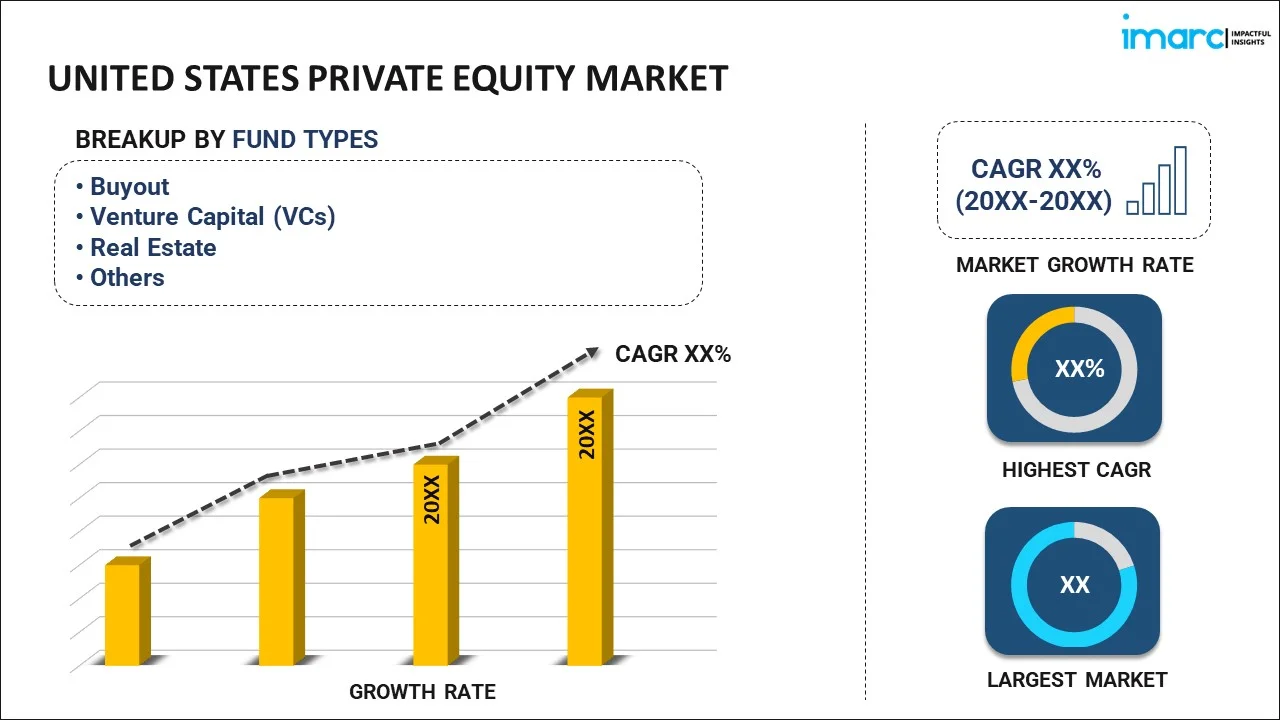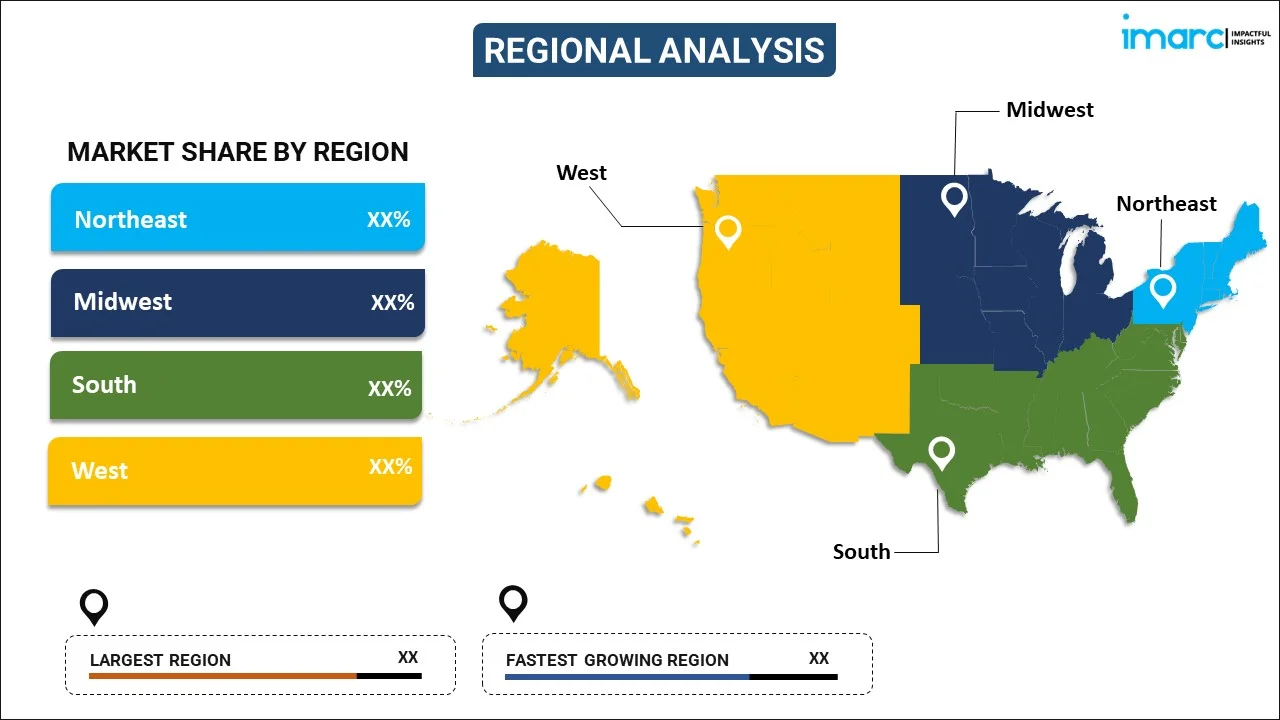
United States Private Equity Market Report by Fund Type (Buyout, Venture Capital (VCs), Real Estate, Infrastructure, and Others), and Region 2025-2033
Market Overview:
The United States private equity market size reached USD 464.6 Billion in 2024. Looking forward, IMARC Group expects the market to reach USD 1,212.8 Billion by 2033, exhibiting a growth rate (CAGR) of 10.2% during 2025-2033. The continuing evolution of tax legislation, which favors capital investments, the presence of a strong economic foundation and regulatory environment conducive to business growth, and technological innovation represent some of the key factors driving the market.
|
Report Attribute
|
Key Statistics
|
|---|---|
|
Base Year
|
2024 |
|
Forecast Years
|
2025-2033
|
|
Historical Years
|
2019-2024
|
| Market Size in 2024 | USD 464.6 Billion |
| Market Forecast in 2033 | USD 1,212.8 Billion |
| Market Growth Rate (2025-2033) | 10.2% |
Private equity refers to a type of investment strategy that involves the acquisition of ownership stakes in private companies or the buyout of public companies to make them private, with the goal of later selling the stake for a profit. This investment approach is distinct from traditional public equity investment, where shares are bought and sold on public stock exchanges. It is generally employed by firms known as private equity firms, which raise funds from institutional investors and high-net-worth individuals and use these funds to acquire stakes in companies. Once the firms receive these stakes, they often take a hands-on approach to management, aiming to improve financial and operational performance to increase the company's value. The private equity industry plays a vital role in the economy by offering alternative sources of capital for enterprises that might not have access to other forms of financing, thus driving growth, innovation, and employment. The private equity realm is characterized by distinct investment phases, beginning with the identification of promising investment targets. Due diligence is meticulously conducted to assess the viability of the investment, including scrutinizing financials, evaluating market positioning, and analyzing growth potential. Once an investment is made, private equity firms actively collaborate with management teams, drawing upon their expertise to formulate strategies that bolster operational efficiency, streamline costs, and optimize resource allocation.
United States Private Equity Market Trends:
The presence of diverse industry sectors across the region majorly drives the market in the United States. This can be supported by the strong economic foundation and regulatory environment conducive to business growth, making it an attractive hub for private equity investment. Along with this, the abundance of high-quality businesses ripe for investment provides ample opportunities for private equity firms to diversify their portfolios and achieve meaningful returns. In addition, technological innovation is another driving force, with private equity firms increasingly targeting technology companies that offer high growth potential in the digital age. Apart from this, the trend of low interest rates has resulted in increased liquidity in the market, motivating more investors to turn to private equity in the search for higher returns. Similarly, the continuing evolution of tax legislation, which favors capital investments, has also provided a further boost to the market. Despite the uncertainties presented by economic cycles, the resilience and adaptability of private equity firms have been crucial in navigating through these fluctuations. Furthermore, the combination of these elements underscores the vitality and growth trajectory of the United States private equity market.
United States Private Equity Market Segmentation:
IMARC Group provides an analysis of the key trends in each segment of the United States private equity market report, along with forecasts at the country level for 2025-2033. Our report has categorized the market based on fund type.
Fund Type Insights:

- Buyout
- Venture Capital (VCs)
- Real Estate
- Infrastructure
- Others
The report has provided a detailed breakup and analysis of the market based on the fund type. This includes buyout, venture capital (VCs), real estate, infrastructure, and others.
Regional Insights:

- Northeast
- Midwest
- South
- West
The report has also provided a comprehensive analysis of all the major regional markets, which include Northeast, Midwest, South, and West.
Competitive Landscape:
The report has also provided a comprehensive analysis of the competitive landscape in the market. Competitive analysis such as market structure, key player positioning, top winning strategies, competitive dashboard, and company evaluation quadrant has been covered in the report. Also, detailed profiles of all major companies have been provided.
United States Private Equity Market Report Coverage:
| Report Features | Details |
|---|---|
| Base Year of the Analysis | 2024 |
| Historical Period | 2019-2024 |
| Forecast Period | 2025-2033 |
| Units | Billion USD |
| Scope of the Report | Exploration of Historical and Forecast Trends, Industry Catalysts and Challenges, Segment-Wise Historical and Predictive Market Assessment:
|
| Fund Types Covered | Buyout, Venture Capital (VCs), Real Estate, Infrastructure, Others |
| Regions Covered | Northeast, Midwest, South, West |
| Customization Scope | 10% Free Customization |
| Post-Sale Analyst Support | 10-12 Weeks |
| Delivery Format | PDF and Excel through Email (We can also provide the editable version of the report in PPT/Word format on special request) |
Key Questions Answered in This Report:
- How has the United States private equity market performed so far and how will it perform in the coming years?
- What has been the impact of COVID-19 on the United States private equity market?
- What is the breakup of the United States private equity market on the basis of fund type?
- What are the various stages in the value chain of the United States private equity market?
- What are the key driving factors and challenges in the United States private equity market?
- What is the structure of the United States private equity market and who are the key players?
- What is the degree of competition in the United States private equity market?
Key Benefits for Stakeholders:
- IMARC’s report offers a comprehensive quantitative analysis of various market segments, historical and current market trends, market forecasts, and dynamics of the United States private equity market from 2019-2033.
- The research study provides the latest information on the market drivers, challenges, and opportunities in the United States private equity market.
- Porter's five forces analysis assist stakeholders in assessing the impact of new entrants, competitive rivalry, supplier power, buyer power, and the threat of substitution. It helps stakeholders to analyze the level of competition within the United States private equity industry and its attractiveness.
- Competitive landscape allows stakeholders to understand their competitive environment and provides an insight into the current positions of key players in the market.
Need more help?
- Speak to our experienced analysts for insights on the current market scenarios.
- Include additional segments and countries to customize the report as per your requirement.
- Gain an unparalleled competitive advantage in your domain by understanding how to utilize the report and positively impacting your operations and revenue.
- For further assistance, please connect with our analysts.
 Inquire Before Buying
Inquire Before Buying
 Speak to an Analyst
Speak to an Analyst
 Request Brochure
Request Brochure
 Request Customization
Request Customization




.webp)




.webp)












